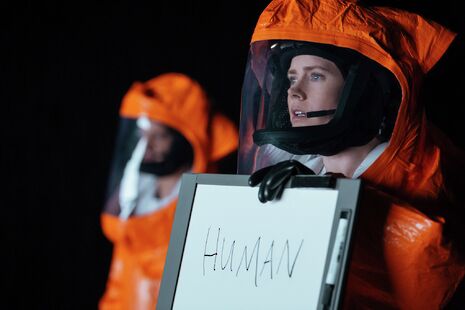Film: Arrival
An ambiguous sci-fi epic, that isn’t afraid to make the audience question themselves

So crucial is the idea of mystery and the impossibility of communication, to Denis Villeneuve’s Arrival, reviewing it proves similarly impossible to do without undermining the film’s efforts to obfuscate. In some reviews, one might place a spoiler warning at the beginning and then launch into a critique extolling its secrets. But so integral is the 'withheld fact' in Arrival, that to reveal all this would be to render seeing the film pointless. You'll have to forgive me in this review, essay-addled reader, for sounding elliptical.
Sonically, Villeneuve populates the soundtrack with discordant tones and screeches, flat notes and abrupt musical interjections, creating a soundscape that renders the familiar settings of the film – a university lecture room, rolling fields, a living room – foreign to us. By the time we have adjusted to the soundtrack, the jarring picture of the alien sanctum the scientists enter seems less suspect. Villeneuve reinforces the idea that these humans are just as alien to us as the aliens are to the humans. On a similar level, the audience remains unclear whose side they are on until the very end.
The film’s most commendable characteristic is its insistence on ambiguity. Eric Heisserer’s script isn’t scared to alienate his audience, in fact, he revels in the uncertainty. The importance of linguistic theory in the film’s plot is neither shied away from nor simplified as the characters explain the importance of language in a way that is sensical but by no means straightforward. Meanwhile, dreams and flashbacks are melded into the plot without a clear difference in visual style and so the viewer is forced into a kind of fugue state, as disoriented by the events of the film as its inhabitants. This deliberate non-pandering to an easy watching allegorises the inestimable nature of considering life beyond this earth.
Villeneuve captures this mystery visually and shows a deft hand in demonstrating the magnificent via the minute. His camera revels in close ups, hinting at the spectacle occurring outside the shot; the majesty registered in the twitch of an eye or a pursed lip. The audience is not fed information but rather has to infer it. When the camera does open up the field of vision, it follows a Malick-like trajectory, following behind the characters as though the audience is experiencing the wonder for the first time with them. At one point, when the aliens’ arrival is announced on the news, Villeneuve places the camera from the perspective of the television, looking at the stunned faces of its viewers as they stare directly at us. It doesn’t take a cinema student to acknowledge the message being transmitted here – who should we be more afraid of and amazed by - the aliens, or ourselves?
With Arrival, Villeneuve enters into the cinematic pantheon of Kubrick and Tarkovsky by offering an alternative vision of the galactic unknown, unafraid to confuse and disturb his audience in the name of mystery.
 News / CUP announces funding scheme for under-represented academics19 December 2025
News / CUP announces funding scheme for under-represented academics19 December 2025 News / Cambridge welcomes UK rejoining the Erasmus scheme20 December 2025
News / Cambridge welcomes UK rejoining the Erasmus scheme20 December 2025 Comment / Yes, I’m brown – but I have more important things to say22 December 2025
Comment / Yes, I’m brown – but I have more important things to say22 December 2025 News / SU reluctantly registers controversial women’s soc18 December 2025
News / SU reluctantly registers controversial women’s soc18 December 2025 Film & TV / Timothée Chalamet and the era-fication of film marketing21 December 2025
Film & TV / Timothée Chalamet and the era-fication of film marketing21 December 2025








